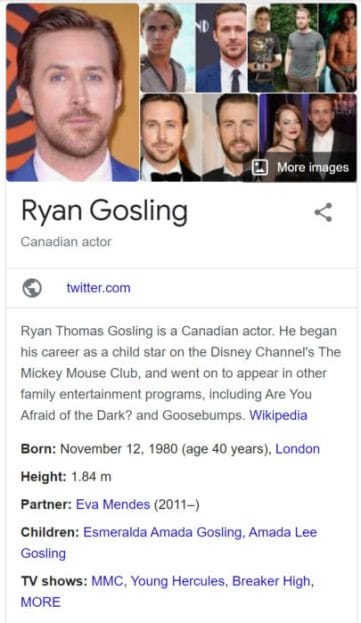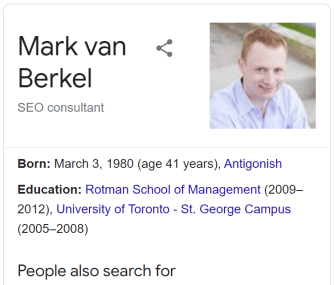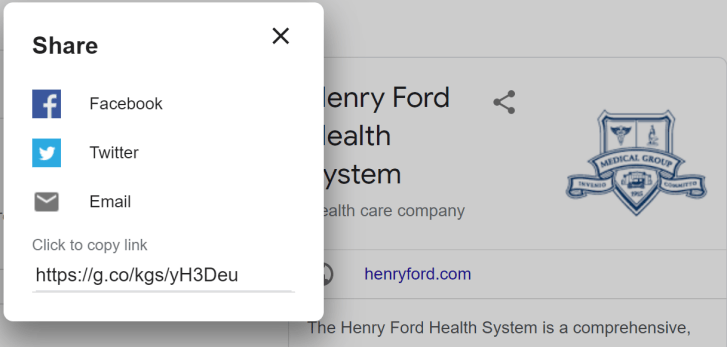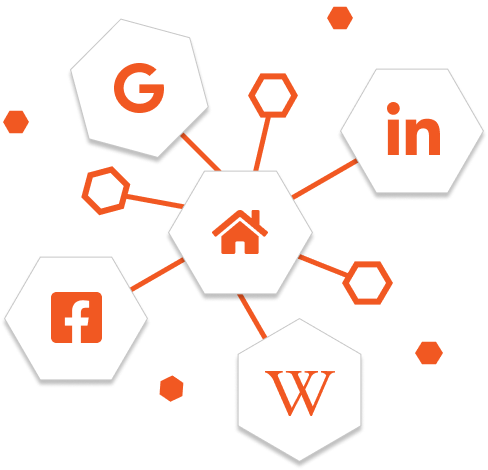When you Google a person, place, organization or thing, you may have noticed an information box popping up on the right-hand side, called the right rail, of Google search results. That’s a Google Knowledge Panel. On desktop, they’re very easy to spot! You can identify a knowledge panel by the share button that appears beside the entity name.

Google Knowledge Panels are information boxes that appear in search results when Google recognizes an entity in a user’s search query. Google pulls this information from entities defined in its knowledge graph and from trusted resources like Wikipedia. You can help Google along by feeding and enhancing your local or branded knowledge panel through structured data like schema markup.
What do knowledge panels look like on mobile devices?
On mobile, screen size doesn’t allow for side-by-side display so information from Google’s Knowledge Graph may be presented by one or more knowledge panels spread among the search engine page results. Mobile knowledge panels for companies display information similar to the desktop version including:
- Company name
- Company Logo
- Link to the company’s website
- Summary of the company
- Contact information
- Links to social media
- Stock prices and revenue (if available and/or applicable)
- People Also Search For carousel
For topic matter, mobile knowledge panels don’t show as much information as a desktop experience because of the limited screen size.
For people, mobile knowledge panels start to get really interesting. Instead of showing a logo like company knowledge panels or corporate panels, for people Google knowledge panels show a carousel of images for the entity in question in a mobile experience. Other carousels that may show at the bottom of a person’s knowledge panel are videos, books, and of course People Also Search For.
What’s great about mobile knowledge panels is that they will show pertinent information for the entity being searched for. For example, when searching for LeBron James, the mobile knowledge panel displays his height, because as a professional basketball player this information is relevant to the search query.

Another feature of mobile knowledge panels is to categorize and display the information in tabs. Looking back at our LeBron James example, you can see different data displayed based on which tab is chosen.
What are the types of Google Knowledge Panels?
There are two types of Google Knowledge Panels: Local and Branded (ex. Organization, Person). This article will explain the differences between them and how to use structured data markup to get a knowledge panel for your online business.
Local Knowledge Panel
Local knowledge panels are information boxes that appear when Google interprets a search query to have local intent. For example, if I search for “Block Three Brewing Company St Jacobs”, a local brewery, its local knowledge panel will display because Google has determined that my search had local intent. You will also see multiple knowledge panels showing throughout the search engine page results.

The first step to getting a local knowledge panel for your company is to create a Google Business Profile account. Google Business Profile (GBP) is the catalyst for a local knowledge panel to show in search results. Once created, you can verify that you’re the owner of that business and start adding in any relevant information that you want to display in Google search. Your Google Business Profile can show your company’s phone number, customer ratings and reviews, address, hours, and more! This information is also shown in your local knowledge panel.
Structured Data for Local Knowledge Panels
You should also verify your website within Google Search Console and add LocalBusiness schema markup. Through this structured data, you define your business as an entity for Google and connect it to other entities defined in Google’s Knowledge Graph. This way, search engines can contextualize your website content and better match it to a user’s search query. Structured data will also increase the chance of Google showing your local knowledge panel in search.
Branded or Personal Knowledge Panels
You can’t apply for a personal or branded knowledge panel, and Google will decide whether you or your brand has enough credibility and authority to warrant one. People and brands who are well-known and have Wikipedia pages dedicated to them often have a knowledge panel appear in Google search. See how Canadian actor Ryan Gosling has a personal Google Knowledge Panel.

However, you don’t need a Wikipedia page to have a personal knowledge panel! Schema App COO and the creator of Schema App Mark van Berkel has a personal knowledge panel without one because he is an established figure in his field with multiple sources and publications supporting his authority.

Personal knowledge panels are particularly challenging for Google. There may be hundreds or thousands of people across the web with the same name, and this ambiguity can lead to confusion for the information within knowledge panels. You can see why defining a home for your entity, the subject of the personal knowledge graph, is so important. Here’s where structured data comes in.
Structured Data for Branded Knowledge Panels
This “entity home” is the authoritative source of information for Google to reference. Examples of entity homes for people are an about me page or homepage on the person’s personal site, the about me page on the person’s company website, or a social profile. We recommend choosing an owned domain instead of a social media profile, as they are only semi-owned so you don’t have absolute authority. Once you have decided on your entity home, mark up all relevant information with structured data to help Google understand the content and better display it in your knowledge panel.
When do knowledge panels appear?
A knowledge panel will appear when Google recognizes an entity in a user’s search query. An entity, or a named entity, is a single, well-defined thing or concept. You can use specific identifiers like @ids or URIs to define objects in your web content as distinct entities with their own properties and relationships to other entities. Once defined, you can link them to Google’s Knowledge Graph using structured data. Once you’ve achieved a Knowledge Graph, your entity will receive a unique URL defining it as a part of Google’s Knowledge Graph. This can be found by clicking the share button beside the entity’s name.

Within your homepage markup, you can then use sameAs to link your organization to the knowledge graph URL, creating another credibility loop for your brand. Link the information on your website to other entities in other knowledge graphs with high E-E-A-T like Wikipedia pages. For example, you can support local search for your brand or local business by using the areaServed property to link to the Wikipedia page for that city, region, or country. Knowledge graphs, more generally, represent the linking of information and data across the web, which allows search engines to contextualize the content you mark up on your website.
The information shown in knowledge panels comes from sources trusted by search engines to have high E-E-A-T. These sources include Wikipedia, Wikidata, LinkedIn, Facebook, and many others. If Google is confident that this information is correct, it is stored in its knowledge graph.
How does structured data feed and enhance knowledge panels?
Does structured data directly trigger Google knowledge panels? The answer is no, but it does feed and enhance your knowledge panel. Adding markup to your website translates your human-readable content into the machine-readable language of JSON-LD, making it easier for search engines to catalogue and contextualize the data on your website.
You’ll likely type your homepage as either a Person, an Organization, a LocalBusiness, or a more specific subtype. Generally speaking, you should use the LocalBusiness type if the business is a brick-and-mortar facility that has address information publicly available. If the business doesn’t have an address associated with it, the Organization type may be the better choice.
The full list of schema.org types can be found in their Full Hierarchy where indentations denote a subtype relationship in the hierarchy of terms. We encourage you to check out schema.org’s definitions for any types that are relevant to your business, that way you can be sure you’re using the most accurate type.
Refer to our Ultimate How-to Guide for Local Business Schema Markup to help you get started!
Adding schema markup to your homepage means your website can be the authoritative source of information for Google’s Knowledge Graph, rather than relying on a Wikipedia page (which you don’t own) or your LinkedIn or Twitter profile (which you only semi-own).
How does structured data enhance credibility and trust?
But wait, didn’t we say above that the information shown in knowledge panels comes from trusted sources like Wikipedia or LinkedIn? This is another area where structured data can help! As you build your homepage markup, be sure to use the sameAs property to link to the appropriate Wikipedia page, LinkedIn profile or Twitter profile and leverage the additional E-E-A-T of these resources. Information about your organization should be consistent across all connected sources, and better yet, if those sources link back to your entity home you create an infinite loop of credibility!

💡 Advanced Tip: use the schema.org property type knowsAbout within your Person or Organization markup to link to an external vocabulary URL, such as Wikipedia, to connect your structured data to Google’s Knowledge Graph.
Google often uses Wikipedia to populate knowledge panels, but it’s important to control your knowledge panel to maintain credibility. Managing the information internally and leveraging schema markup provides the best approach.
How long until my knowledge panel starts showing on Google?
The timeline for your knowledge panel to appear varies. If you’re relying on a Wikipedia article for your organization, your knowledge panel could appear in a few days. If you don’t rely on Wikipedia, it could take a few months. In this case, it’s better to wait so you have more control over the information appearing in your knowledge panel.
How do I claim my knowledge panel?
Before you can claim your knowledge panel, you need to be verified by Google as an authorized representative of your organization:
- Ensure that you have a Google account and, if not, create a new one
- Go to Google Search
- Search for yourself or for your organization (the entity you are representing for the knowledge panel)
- Scroll to the bottom and click Claim This Knowledge Panel
When you click on the option to “Claim this Knowledge Panel”, you’ll be redirected to Google Search Console. Learn more about claiming your Google Knowledge Panel here.
Why should my brand have a knowledge panel?
We’re used to seeing knowledge panels for prominent brands in search results, so if your brand is missing a knowledge panel, you may not appear as credible to users. Your brand will be able to capture users at different parts of the customer journey and funnel by providing information about your organization through your knowledge panel.
Helping you gain a knowledge panel for your organization is only one of the many benefits that come from structured data markup. We’ve helped customers like SAP and Sharp Healthcare increase their clicks, impressions and click-through rates for organic search traffic through structured data, with strategies tailored to each brand’s online business goals.
Do you need help enhancing your Google Knowledge Panel?

